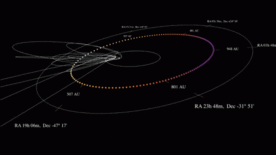
Get ready, Planet Nine — science is coming for you.
Researchers at Yale and elsewhere are drawing tantalizingly close to finding the location of the much-discussed Planet Nine, a planet thought to be orbiting in a remote part of our solar system.
On Saturday, April 29, at 2 p.m., California Institute of Technology astronomer Konstantin Batygin will give a free public talk, “Planet Nine From Outer Space,” at Davies Auditorium, 15 Prospect St.
YaleNews recently asked Yale astronomy professor Gregory Laughlin to talk about the upcoming lecture and about Yale’s research on Planet Nine.
What is Planet Nine, and why are so many researchers looking for it?
Planet Nine is a world that’s hypothesized to orbit in the far outer reaches of our own solar system. It has not yet been observed directly, but its gravitational influence seems to be affecting the orbits of small icy objects — the members of the Kuiper Belt — that lie beyond the planet Neptune. The trajectories of the most distant Kuiper Belt objects are curiously aligned, in a configuration that is very unlikely due to chance, which seems to strongly hint at the presence of an unseen planet.
If it’s out there, Planet Nine is likely about 6 to 10 times as massive as Earth, and it would currently be about 1,000 times farther away from the Sun than Earth. At that distance, the sunlight is diminished by a factor of 1 million, and so it’s very hard to detect. So it’s both a grand challenge from the standpoint of an observational search, and, if it exists, it would allow us to test our theories about what planets in this as-yet unprobed mass range are like. We know that the galaxy is teeming with super-Earth mass planets, so finding one in our own backyard would be super exciting.
Can you put your own research into context with other efforts that are ongoing?
Over the past year here at Yale, I’ve collaborated with astronomy graduate student Sarah Millholland in an effort to pin down Planet Nine’s sky position. Sarah has shown that the ratios of the orbital periods of the most distant Kuiper Belt objects are very close to integer ratios. This suggests that they are all in gravitational “resonance” with a more distant massive object, which we hypothesize is Planet Nine. Using a large suite of simulations, done over the course of two months with Yale’s High-Performance Computing resources, we think we’ve potentially isolated the patch of sky where it’s most likely to be.
What was your most recent finding?
If Planet Nine is out there, and of course that’s a big “if,” we think it’s located in the direction of the constellation Cetus. Sarah has made a nice interactive web demonstration that shows our model of its three-dimensional orbit.
Can you talk a bit about the upcoming campus visit from Konstantin Batygin?
We’re really excited that Konstantin Batygin, an astronomer from Caltech who is one of the primary architects of the current Planet Nine hypothesis, is coming to Yale this week to give a series of lectures. On Saturday April 29, at 2 p.m., he’ll be giving a public talk. He’ll delve into why we think Planet Nine is out there, and he’ll give some up-to-the-minute insights about the current status of the observational searches for it. We’re encouraging everyone to come, both kids and adults. He’s a great speaker, and it’s a really exciting topic.